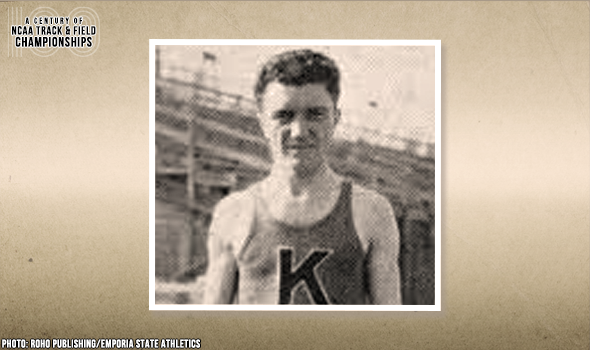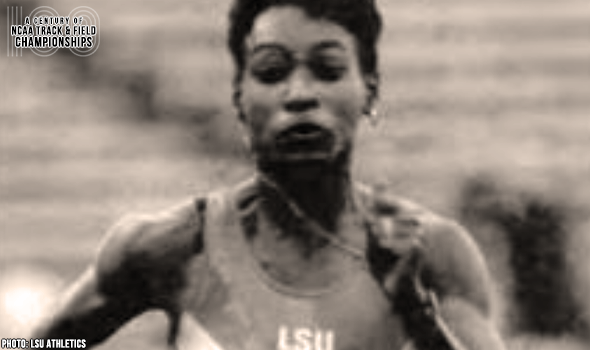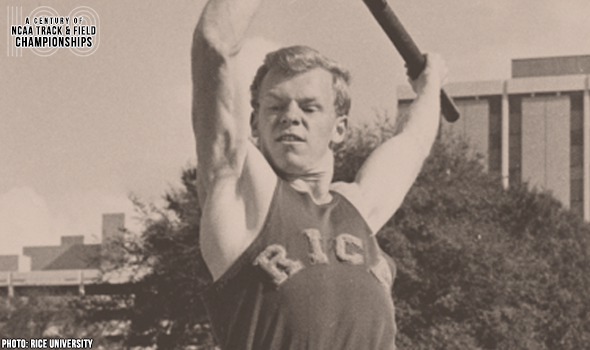
Gordy Played Hero, Sent LSU To Team Title
“A team that possesses an unknown boy who can turn in a ‘pressure’ stunt like that deserves to win a team championship.” ~ Maxwell Stiles, Los Angeles Times
The team title at the 1933 NCAA Track & Field Championships in Chicago turned into a thrilling battle between programs at opposite ends of experience in the meet.
Nowhere was that more evident than in the concluding event, the pole vault.
Southern California was then in its early days of dominating the NCAA Championships (The Trojans were seeking a fourth team crown in eight years) and had the favorite in the event – world-record holder Bill Graber. His lofty personal-best of 14-4⅜ (4.37m) was more than six inches ahead of his then-meet-record standard of 13-10¼ (4.22m) set two years prior where he was crowned co-champion.
LSU was making its first appearance at the NCAA Championships and entered little-known Matt Gordy, who had a best of 13-4 (4.06m). A month earlier, he was part of a three-way tie to win the inaugural Southeastern Conference meet.
Teamwise, LSU surprisingly led USC 49-45 going into the pole vault. However, the Trojans had a path to team victory that lost a major obstacle when the four vaulters who cleared 13-6 (4.11m) did not include Stanford’s William Miller, the reigning Olympic gold medalist.
With Graber’s most-feared threat out of the competition, most felt if anyone could challenge him it would be one of the Midwest pair of Ernest Lennington (Illinois) and John Wonsowicz (Ohio State), both of whose 13-6 clearance matched their best from 1932 when they were among a six-way tie for second.
No one gave Gordy much chance, as his 13-6 clearance was not only a PR but also matched the best he’d ever done in practice.
With the bar raised to the meet-record height of just over 13-11 (4.24m) – PR territory for all but Graber – the USC senior sailed over on his second attempt. Only Gordy remained after Lennington and Wonsowicz missed their third attempts.
The team crown was also in the balance: A clearance by the Tiger senior meant Gordy and Graber would tie and LSU would win 58-54, while a miss would give Gordy a share of second and LSU would tie USC with 55 points each.
Gordy nudged the bar, but got over, bringing many fans to swarm the co-champion in celebration. As officials did not raise the bar any higher, the event and meet were over, giving the Tigers the team title that many consider one of the meet’s biggest upsets.
“A team that possesses an unknown boy who can turn in a ‘pressure’ stunt like that deserves to win a team championship,” wrote Maxwell Stiles of the Los Angeles Times.
The NCAA and collegiate track & field will mark a momentous milestone in the spring of 2021 -- the 100th anniversary of the NCAA Championships and with that, the NCAA Track & Field Championships. In June 1921, the University of Chicago hosted the first track & field championships in NCAA history.
This point can’t be emphasized enough: Not only was the event the first for NCAA track & field, but the first championships for any sport under the sponsorship of the NCAA.
To celebrate, over each of the next 365 days, the U.S. Track & Field and Cross Country Coaches Association (USTFCCCA) will celebrate moments, student-athletes, and coaches that have made a century’s worth of championships special. From humble beginnings to important historical milestones to the modern-day, collegiate track & field has evolved with the American society.
The 2021 edition of the NCAA Division I Outdoor Track & Field Championships begin with preliminary round action on May 27-29 in Jacksonville, Fla., and College Station, Texas. The championships final site and culmination of the celebration is slated for June 9-12, 2021 at the newly rebuilt Hayward Field in Eugene, Ore.

Clemson’s Ross Kept Getting Faster In 1995
Duane Ross PR’d twice in the 110H at the 1995 NCAA DI Outdoor T&F Championships. When Ross won in 13.32, he became the No. 3 performer in collegiate history.

Illinois’ Kerr Went Back-To-Back At NCAAs
George Kerr won back-to-back 800/880 titles at the NCAA Outdoor T&F Championships in 1959 & 1960. Kerr set a meet record of 1:46.4 in the 800 meters in 1960.

UCLA’s Baucham Bounded To TJ CR In 2005
Candice Baucham won the triple jump at the 2005 NCAA DI Outdoor T&F Championships with a collegiate record of 14.07m (46-2). Baucham took the event by more than one foot.

San Romani Went From Unknown To Legend
Archie San Romani won back-to-back 1500/mile crowns at the NCAA Outdoor T&F Championships in 1935 & 1936.

Auburn’s Glance Made Them Look Twice
Harvey Glance completed the 100-200 double as a freshman at the 1976 NCAA DI Outdoor T&F Championships. He set a meet record of 10.16 in the 100.

Nova’s Rhines Did NCAA 5K Three-Peat
Jen Rhines was the first female athlete in the history of the NCAA DI Outdoor T&F Championships to win three consecutive 5K titles.

Georgia’s Erm Cruised To 2019 Decathlon Title
Johannes Erm won the decathlon at the 2019 NCAA DI Outdoor T&F Championships by 342 points with his 8352 total. That was also the fifth-best score in meet history.

McMillen Adapted, Set 1500 MR In 1952
Bob McMillen set a meet record in the 1500 meters of 3:50.7 at the 1952 NCAA Outdoor Track & Field Championships.

LSU’s Duhaney Destroyed NCAA 200 Field In 1992
Dahlia Duhaney owns the largest margin of victory in meet history in the 200 with her 0.44-second winner at the 1992 NCAA DI Outdoor T&F Championships.

Rice’s Roberts Cooked Up Pole Vault Greatness
Dave Roberts was the second man to win three consecutive pole vault titles at the NCAA DI Outdoor T&F Championships, doing so from 1971 to 1973.

